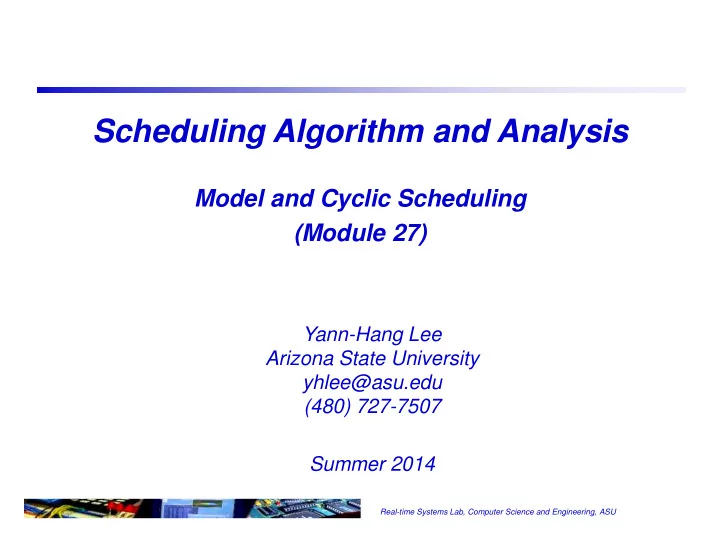

Scheduling Algorithm and Analysis Model and Cyclic Scheduling (Module 27) Yann-Hang Lee Arizona State University yhlee@asu.edu (480) 727-7507 Summer 2014 Real-time Systems Lab, Computer Science and Engineering, ASU
Task Scheduling Schedule: to determine which task is assigned to a processor at any time order of execution meet deadlines, fast response time, utilize resource effectively Need an algorithm to generate a schedule optimal scheduling algorithm: always find a feasible schedule if and only if a feasible schedule exists Scheduler or dispatcher: the mechanism to implement a schedule Misconcept: RTOS will schedule tasks to meet task deadlines A good schedule will reduce CPU load 1 Real-time Systems Lab, Computer Science and Engineering, ASU
Task Functional Parameters Preemptivity: suspend the executing job and switch to the other one should a job (or a portion of job) be preemptable context switch: save the current process status (PC, registers, etc.) and initiate a ready job transmit a UDP package, write a block of data to disk, a busy waiting loop Preemptivity of resources: concurrent use of resources or critical section lock, semaphore, disable interrupts How can a context switch be wake-up waiting ready triggered? Assume you want to preempt an executing job -- why suspended blocked a higher priority job arrives dispatched executing run out the time quantum 2 Real-time Systems Lab, Computer Science and Engineering, ASU
Event- and Time-Triggered Systems Time-triggered control system All activities are carried out at certain points in time know a priori at design time (based on a globally synchronized time base) Transmission of messages Task execution Monitoring of external states All nodes have a common notion of time Event-triggered control system All activities are carried out in response to events external to the system Reception of a message Termination of a task External interrup 3 Real-time Systems Lab, Computer Science and Engineering, ASU
Major and Minor Cycle Model Time is divided into equal-sized frame minor cycle = length of frame Major cycle = length of schedule = k * minor_cycle An example: A=(10,4) B=(20,6) C=(30,5) major cycle=60, minor cycle=10 scheduling string AB_AC_AB_AC_AB_A_ Jobs must be done within a minor cycle limit timing error to one frame suspend and resume as background, continue, or abort if overrun 0 10 20 30 40 50 60 4 Real-time Systems Lab, Computer Science and Engineering, ASU
An Example A1 must be done at least every 10ms, and takes 1ms A2 must be completed with 5ms when E occurs and takes 2 ms E must be detected by polling and is detectable for at least 0.5 ms 0.5ms E would not occur twice within 50 ms polling of E takes 0 overhead 5 Real-time Systems Lab, Computer Science and Engineering, ASU
Major/Minor Cyclic Scheduling There should be a periodic polling action for E Assume a timer of 0.5ms to activate polling operation and no polling overhead Should be an interval of 2ms to execute A2 for an arbitrary 5ms interval May detect E in the first frame and execute A2 in the second frame ⇒ period=2.5ms A2 takes 2ms if E, otherwise is 0 ⇒ WCET=2ms Should be an interval of 1ms to execute A1 for an arbitrary 10ms interval Period= 10ms, WCET= 1ms Since 2ms + 1ms > 2.5ms, we will divide A1 into two parts of 0.5ms A2 A1_1 A2 A1_2 A2 A2 A2 A1_1 A2 A1_2 A2 A2 6 Real-time Systems Lab, Computer Science and Engineering, ASU
Summary of Cyclic Schedule Pros simple, table-driven, easy to validate (knows what is doing at any moment) fit well for harmonic periods and small system variations static schedule ⇒ deterministic, static resource allocation, no preemption small jitter no scheduling anomalies Cons difficult to change (need to re-schedule all tasks) fixed released times for the set of tasks difficult to deal with different temporal dependencies schedule algorithm may get complex (NP-hard) doesn’t support aperiodic and sporadic tasks efficiently 7 Real-time Systems Lab, Computer Science and Engineering, ASU
Recommend
More recommend